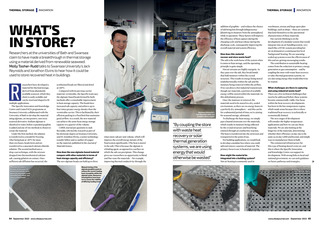




THERMAL STORAGE | INNOVATION WHATS IN STORE? Researchers at the universities of Bath and Swansea claim to have made a breakthrough in thermal storage using a material derived from renewable seaweed. Molly Tooher-Rudd talks to Swansea Universitys Jack Reynolds and Jonathon Elvins to hear how it could be used to store recovered heat in buildings R esearchers have developed a material for thermal storage, derived from abundantly available seaweed, which they claim is easily scalable and can be sized and shaped to fit multiple applications. The Specific Innovation and Knowledge Centre and Coated M2A programme at Swansea University collaborated with the University of Bath to develop the material using alginate, an inexpensive, non-toxic seaweed derivative. Sodium alginate is dissolved in water, before expanded graphite is added and one of two methods is chosen to create the material. Under the first method, the solution is transferred to a mould for freezing. After being kept at -20C for more than two hours, beads form and are transferred to a saturated calcium chloride solution. The second method uses a drop-cast technique, with the mixture dropped into thermochemical calcium salt, causing gelation on contact. Once sufficient salt diffusion has occurred, the The graphite used in the mix. A few types are being investigated, some which are expanded, some expanded and milled, and others a fine powder 64 September 2023 www.cibsejournal.com synthesised beads are filtered and dried at 120C. Compared with its previous carrier material, vermiculite, the Specific team says the alginate-based beads formed by both methods offer a remarkable improvement in heat-storage capacity. The beads have increased salt capacity and achieve up to four times greater energy density than the vermiculite carrier. This is facilitated by their efficient packing in a fixed bed that maintains good airflow. As a result, the new material can achieve the same heat energy storage capacity in a quarter of the volume. CIBSE Journal put questions to Jack Reynolds, who led the research as part of his doctorate degree at Swansea University, and Dr Jonathon Elvins, a senior technology transfer fellow and co-author of a paper on the material, published in the Journal of Materials Science. How does the new alginate-based material compare with other materials in terms of heat storage capacity and efficiency? The new alginate beads can hold up to three Manual mixing of the alginate/graphite paste to achieve the correct loading level of graphite within the alginate paste. Numerous investigations have been run to assess the viability of differing loading levels times more salt per unit volume, which will improve the overall energy density of the final system significantly. (The heat is stored in the salt.) This is because the alginate is a binding agent, as opposed to a surface on which the salt can precipitate. This change gives our researchers an opportunity to blend and fine-tune the materials for example, improving thermal conductivity through the